Improving the Classification Accuracy of Annual Crops Using Time Series of Temperature and Vegetation Indices
Abstract
:1. Introduction
2. Materials and Methods
2.1. Study Area
2.2. Data
2.3. Methods
2.3.1. NDVI Calculation
2.3.2. Temperature Index mLSTI
2.3.3. Multiple Time Series Construction
2.3.4. Random Forest Classifier
2.3.5. Accuracy Assessment and Analysis
3. Results
3.1. NDVI and mLSTI of Each Study Area
3.2. Classification Results Based on NDVI + mLSTI Long Time Series
3.3. Classification Results Based on Short Time Series Feature
4. Discussion
4.1. Effect of Adding mLSTI on Classification Accuracy
4.2. Effect of Adding mLSTI Time Series on Differentiating Crops
4.3. Analysis of the Reasons for Varying Accuracy after Adding mLSTI
5. Conclusions
Author Contributions
Funding
Acknowledgments
Conflicts of Interest
References
- Siachalou, S.; Mallinis, G.; Tsakiri-Strati, M. A hidden markov models approach for crop classification: Linking crop phenology to time series of multi-sensor remote sensing data. Remote Sens. 2015, 7, 3633–3650. [Google Scholar] [CrossRef] [Green Version]
- Murthy, C.S.; Raju, P.V.; Badrinath, K.V.S. Classification of wheat crop with multi-temporal images: Performance of maximum likelihood and artificial neural networks. Int. J. Remote Sens. 2003, 24, 4871–4890. [Google Scholar] [CrossRef]
- Turker, M.; Arikan, M. Sequential masking classification of multi-temporal Landsat7 ETM+ images for field-based crop mapping in Karacabey, Turkey. Int. J. Remote Sens. 2005, 26, 3813–3830. [Google Scholar] [CrossRef]
- Ozdogan, M.; Gutman, G. A new methodology to map irrigated areas using multi-temporal MODIS and ancillary data: An application example in the continental US. Remote Sens. Environ. 2008, 112, 3520–3537. [Google Scholar] [CrossRef] [Green Version]
- Kussul, N.; Lemoine, G.; Gallego, J.; Skakun, S.; Lavreniuk, M. Parcel based classification for agricultural mapping and monitoring using multi-temporal satellite image sequences. In Proceedings of the International Geoscience and Remote Sensing Symposium 2015 (IGARSS 2015), Milan, Italy, 26–31 July 2015; IEEE: New York, NY, USA, 2015. [Google Scholar]
- Hao, P.; Niu, Z.; Wang, L. Crop classification using multi-temporal HJ satellite images: Case study in Kashgar, Xinjiang. In Proceedings of the Land Surface Remote Sensing II, Beijing, China, 13–16 October 2014; International Society for Optical Engineering: Bellingham, WA, USA, 2014; Volume 9260, p. 926005. [Google Scholar] [CrossRef]
- Vieira, C.; Mather, P.; McCullagh, M. The spectral-temporal response surface and its use in the multi-sensor, multi- temporal classification of agricultural crops. Int. Arch. Photogramm. Remote Sens. Spat. Inf. Sci. ISPRS Arch. 2000, 33, 582–589. [Google Scholar]
- Zhang, M.; Li, Q.; Wu, B. Investigating the capability of multi-temporal Landsat images for crop identification in high farmland fragmentation regions. In Proceedings of the International Conference on Agro-Geoinformatics, Shanghai, China, 2–4 August 2012; IEEE: New York, NY, USA; pp. 1–4. [Google Scholar] [CrossRef]
- Kussul, N.; Skakun, S.; Shelestov, A.; Lavreniuk, M.; Yailymov, B.; Kussul, O. Regional scale crop mapping using multi-temporal satellite imagery. Int. Arch. Photogramm. Remote Sens. Spat. Inf. Sci. ISPRS Arch. 2015, 40, 45–52. [Google Scholar] [CrossRef] [Green Version]
- Celik, Y.B.; Sertel, E.; Ustundag, B.B. Identification of corn and cotton fields using multi-temporal Spot6 NDVI data. In Proceedings of the 2015 Fourth International Conference on Agro-Geoinformatics, Istanbul, Turkey, 20–24 July 2015; IEEE: New York, NY, USA; pp. 23–26. [Google Scholar]
- Jakubauskas, M.E.; Legates, D.R.; Kastens, J.H. Crop identification using harmonic analysis of time-series AVHRR NDVI data. Comput. Electron. Agric. 2003, 37, 127–139. [Google Scholar] [CrossRef]
- Wardlow, B.D.; Egbert, S.L.; Kastens, J.H. Analysis of time-series MODIS 250 m vegetation index data for crop classification in the U.S. Central Great Plains. Remote Sens. Environ. 2007, 108, 290–310. [Google Scholar] [CrossRef] [Green Version]
- Simonneaux, V.; Duchemin, B.; Helson, D.; Er-Raki, S.; Olioso, A.; Chehbouni, A.G. The use of high-resolution image time series for crop classification and evapotranspiration estimate over an irrigated area in central Morocco. Int. J. Remote Sens. 2008, 29, 95–116. [Google Scholar] [CrossRef] [Green Version]
- Vintrou, E.; Desbrosse, A.; Bégué, A.; Traoré, S.; Baron, C.; Lo Seen, D. Crop area mapping in West Africa using landscape stratification of MODIS time series and comparison with existing global land products. Int. J. Appl. Earth Obs. Geoinf. 2012, 14, 83–93. [Google Scholar] [CrossRef]
- Xinchuan, L.; Xingang, X.; Jihua, W.; Hongfeng, W.; Yansong, B. Crop classification recognition based on time-series images from hj satellite. Nongye Gongcheng Xuebao/Trans. Chin. Soc. Agric. Eng. 2013, 29, 2013. [Google Scholar] [CrossRef]
- Piedelobo, L.; Hernández-López, D.; Ballesteros, R.; Chakhar, A.; Del Pozo, S.; González-Aguilera, D.; Moreno, M.A. Scalable pixel-based crop classification combining Sentinel-2 and Landsat-8 data time series: Case study of the Duero river basin. Agric. Syst. 2019, 171, 36–50. [Google Scholar] [CrossRef]
- Conrad, C.; Colditz, R.R.; Dech, S.; Klein, D.; Vlek, P.L.G. Temporal segmentation of MODIS time series for improving crop classification in Central Asian irrigation systems. Int. J. Remote Sens. 2011, 32, 8763–8778. [Google Scholar] [CrossRef]
- Hao, P.; Tang, H.; Chen, Z.; Liu, Z. Early-season crop mapping using improved artificial immune network (IAIN) and Sentinel data. PeerJ 2018, 1–30. [Google Scholar] [CrossRef]
- De Souza, C.H.W.; Mercante, E.; Johann, J.A.; Lamparelli, R.A.C.; Uribe-Opazo, M.A. Mapping and discrimination of soya bean and corn crops using spectro-temporal profiles of vegetation indices. Int. J. Remote Sens. 2015, 36, 1809–1824. [Google Scholar] [CrossRef]
- Stan, F.I.; Neculau, G.; Zaharia, L.; Ioana-Toroimac, G. Evapotranspiration variability of different plant types at romanian experimental evapometric measurement stations. Climatologie 2014, 11, 1962–1966. [Google Scholar] [CrossRef]
- Al-Kaisi, M.M.; Broner, I. Crop water use and growth stages. Colo. State Univ. Ext. 2009, 4, 4–9. [Google Scholar]
- DeJonge, K.C.; Taghvaeian, S.; Trout, T.J.; Comas, L.H. Comparison of canopy temperature-based water stress indices for maize. Agric. Water Manag. 2015, 156, 51–62. [Google Scholar] [CrossRef]
- Siebert, S.; Webber, H.; Zhao, G.; Ewert, F. Heat stress is overestimated in climate impact studies for irrigated agriculture. Environ. Res. Lett. 2017, 12. [Google Scholar] [CrossRef]
- Meier, F.; Scherer, D. Spatial and temporal variability of urban tree canopy temperature during summer 2010 in Berlin, Germany. Theor. Appl. Climatol. 2012, 110, 373–384. [Google Scholar] [CrossRef]
- Blum, M.; Lensky, I.M.; Nestel, D. Estimation of olive grove canopy temperature from MODIS thermal imagery is more accurate than interpolation from meteorological stations. Agric. For. Meteorol. 2013, 176, 90–93. [Google Scholar] [CrossRef]
- NASS, USDA. 2017 California Cropland Data Layer; USDA, NASS Marketing and Information Services Office: Washington, DC, USA, 2017. Available online: https://nassgeodata.gmu.edu/CropScape/ (accessed on 26 January 2018).
- NASS, USDA. 2016 Kansas Cropland Data Layer; USDA, NASS Marketing and Information Services Office: Washington, DC, USA, 2016. Available online: https://nassgeodata.gmu.edu/CropScape/ (accessed on 30 January 2017).
- NASS, USDA. 2019 Texas Cropland Data Layer; USDA, NASS Marketing and Information Services Office: Washington, DC, USA, 2019. Available online: https://nassgeodata.gmu.edu/CropScape/ (accessed on 3 February 2020).
- Vermote, E.; Justice, C.; Claverie, M.; Franch, B. Preliminary analysis of the performance of the Landsat 8/OLI land surface reflectance product. Remote Sens. Environ. 2016, 185, 46–56. [Google Scholar] [CrossRef] [PubMed]
- Cook, M.J.; Schott, J.R. Initial validation of atmospheric compensation for a Landsat land surface temperature product. In Algorithms and Technologies for Multispectral, Hyperspectral, and Ultraspectral Imagery XIX; International Society for Optics and Photonics: Bellingham, WA, USA, 2013; Volume 8743, p. 874314. [Google Scholar] [CrossRef]
- Cook, M.; Schott, J.R.; Mandel, J.; Raqueno, N. Development of an operational calibration methodology for the Landsat thermal data archive and initial testing of the atmospheric compensation component of a land surface temperature (LST) product from the archive. Remote Sens. 2014, 6, 11244–11266. [Google Scholar] [CrossRef] [Green Version]
- Howard, D.M.; Wylie, B.K.; Tieszen, L.L. Crop classification modelling using remote sensing and environmental data in the Greater Platte River Basin, USA. Int. J. Remote Sens. 2012, 33, 6094–6108. [Google Scholar] [CrossRef]
- Li, Q.; Wang, C.; Zhang, B.; Lu, L. Object-based crop classification with Landsat-MODIS enhanced time-series data. Remote Sens. 2015, 7, 16091–16107. [Google Scholar] [CrossRef] [Green Version]
- Hao, P.; Zhan, Y.; Wang, L.; Niu, Z.; Shakir, M. Feature selection of time series MODIS data for early crop classification using random forest: A case study in Kansas, USA. Remote Sens. 2015, 7, 5347–5369. [Google Scholar] [CrossRef] [Green Version]
- Momm, H.G.; ElKadiri, R.; Porter, W. Crop-type classification for long-term modeling: An integrated remote sensing and machine learning approach. Remote Sens. 2020, 12, 449. [Google Scholar] [CrossRef] [Green Version]
- Boryan, C.G.; Yang, Z.; Willis, P. US geospatial crop frequency data layers. In Proceedings of the Third International Conference on Agro-geoinformatics, Beijing, China, 11–14 August 2014; IEEE: New York, NY, USA. [Google Scholar] [CrossRef]
- Ji, S.; Zhang, C.; Xu, A.; Shi, Y.; Duan, Y. 3D convolutional neural networks for crop classification with multi-temporal remote sensing images. Remote Sens. 2018, 10, 75. [Google Scholar] [CrossRef] [Green Version]
- Rodriguez-Galiano, V.F.; Ghimire, B.; Rogan, J.; Chica-Olmo, M.; Rigol-Sanchez, J.P. An assessment of the effectiveness of a random forest classifier for land-cover classification. ISPRS J. Photogramm. Remote Sens. 2012, 67, 93–104. [Google Scholar] [CrossRef]
- Liu, J.; Feng, Q.; Gong, J.; Zhou, J.; Liang, J.; Li, Y. Winter wheat mapping using a random forest classifier combined with multi-temporal and multi-sensor data. Int. J. Digit. Earth 2018, 11, 783–802. [Google Scholar] [CrossRef]
- Breiman, L. ST4_Method_Random_Forest. Mach. Learn. 2001, 45, 5–32. [Google Scholar] [CrossRef] [Green Version]
- Cutler, A.; Cutler, D.R.; Stevens, J.R. Random forests. Ensemble Mach. Learn. 2012. [Google Scholar] [CrossRef]
- Jhonnerie, R.; Siregar, V.P.; Nababan, B.; Prasetyo, L.B.; Wouthuyzen, S. Random Forest Classification for Mangrove Land Cover Mapping Using Landsat 5 TM and ALOS PALSAR Imageries. Procedia Environ. Sci. 2015, 24, 215–221. [Google Scholar] [CrossRef] [Green Version]
- Hay, A.M. Remote sensing letters the derivation of global estimates from a confusion matrix. Int. J. Remote Sens. 1988, 9, 1395–1398. [Google Scholar] [CrossRef]
- Bruzzone, L.; Roli, F.; Serpico, S.B. An Extension of the Jeffreys-Matusita Distance to Multiclass Cases for Feature Selection. IEEE Trans. Geosci. Remote Sens. 1995, 33, 1318–1321. [Google Scholar] [CrossRef] [Green Version]


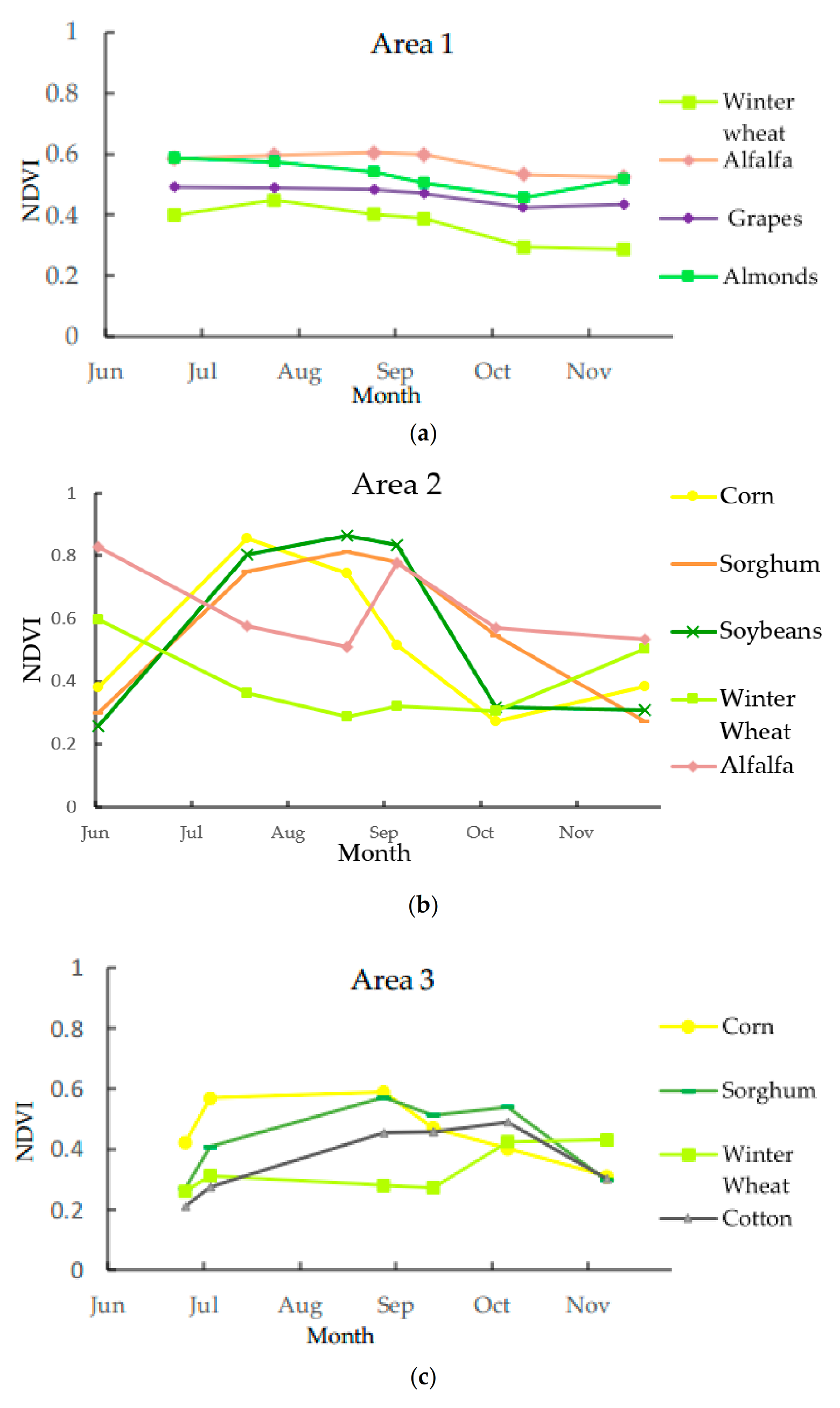



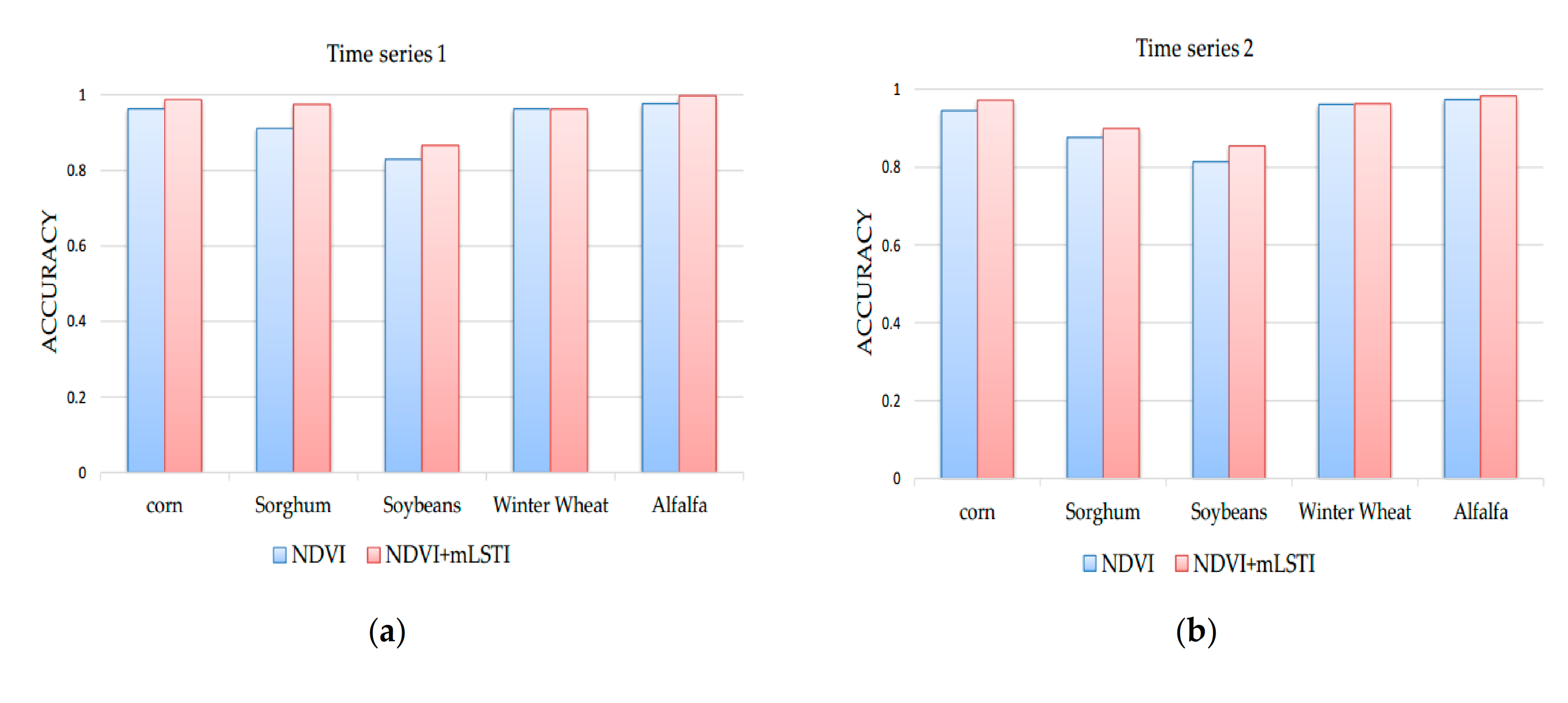

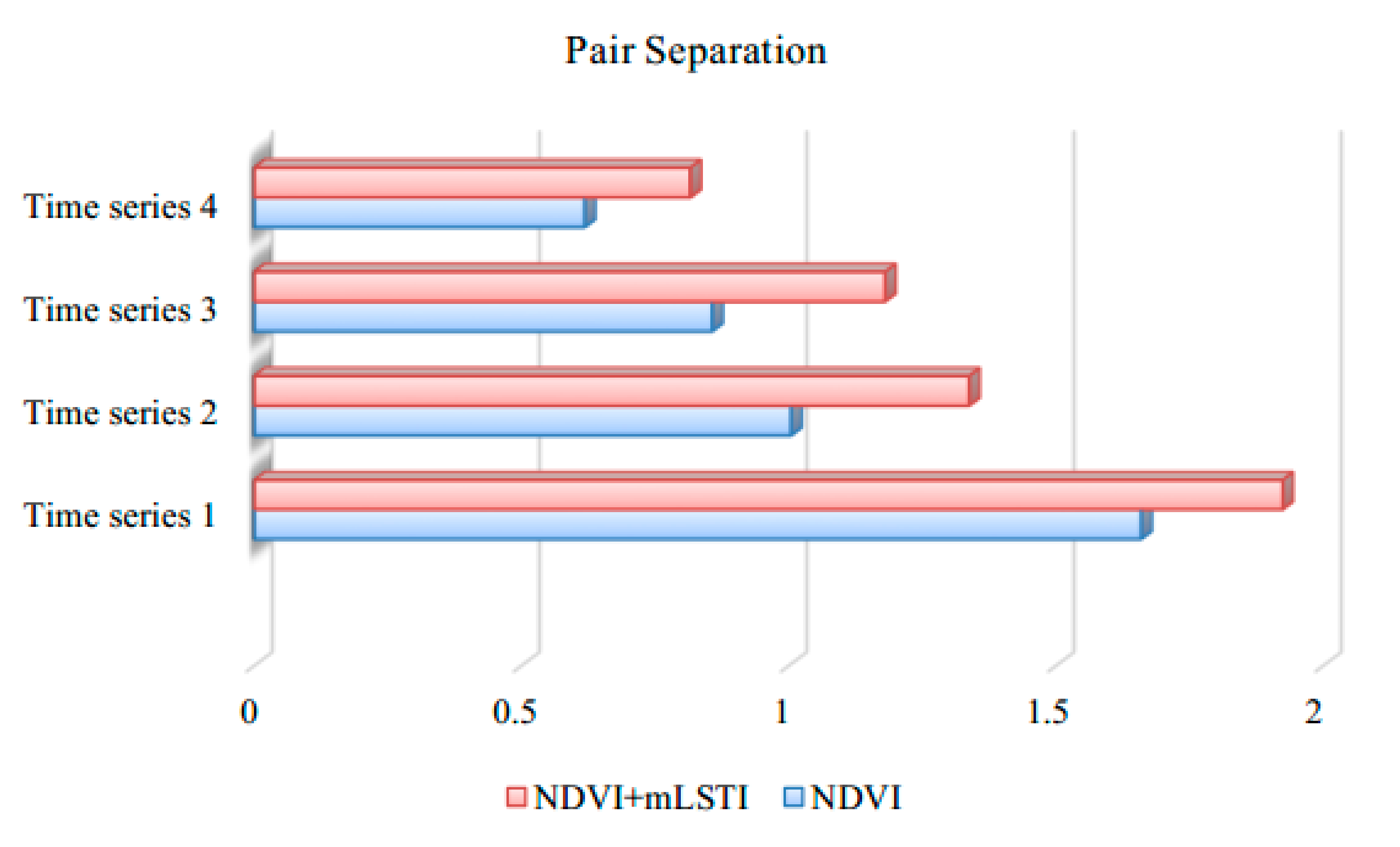


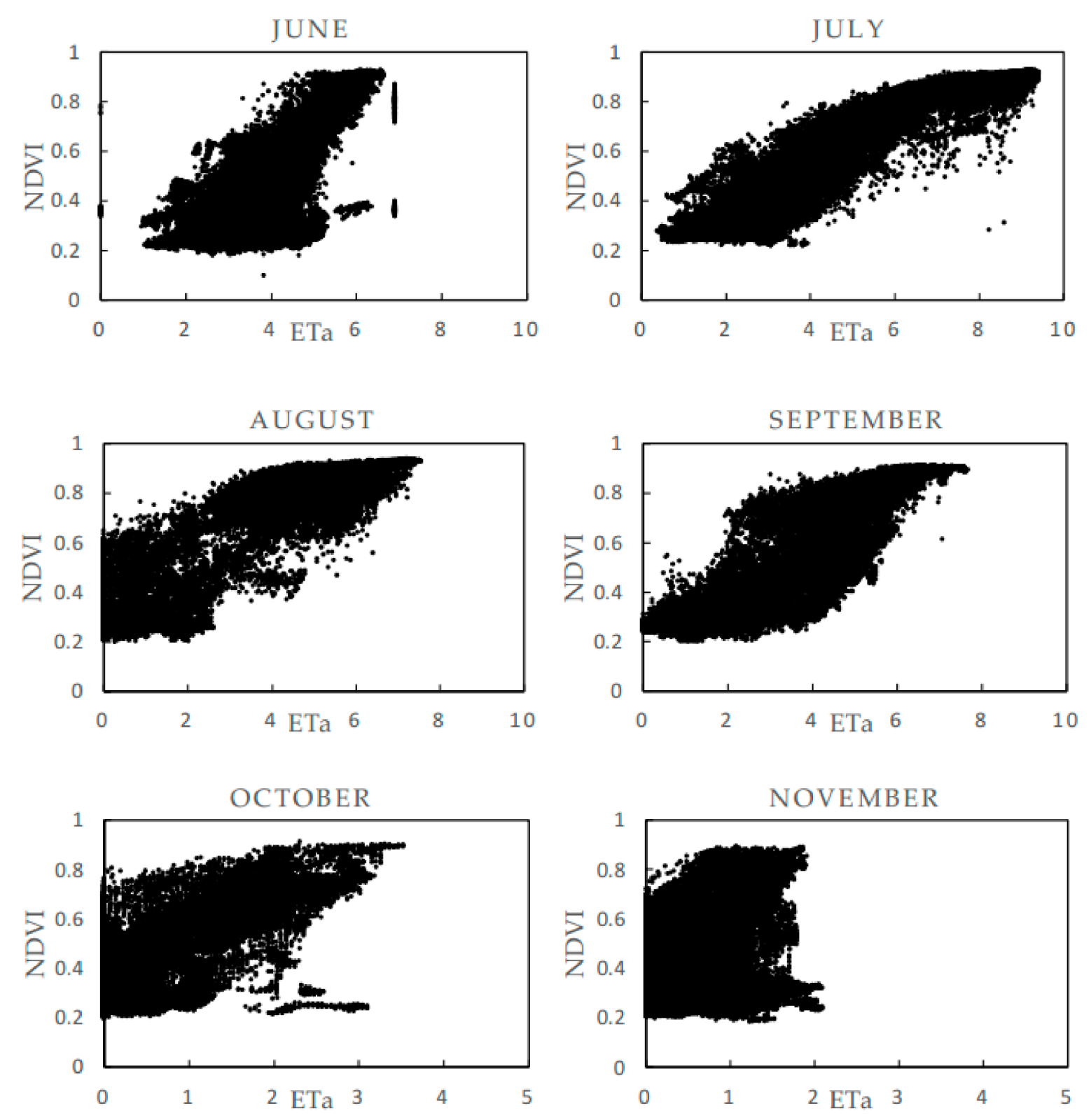
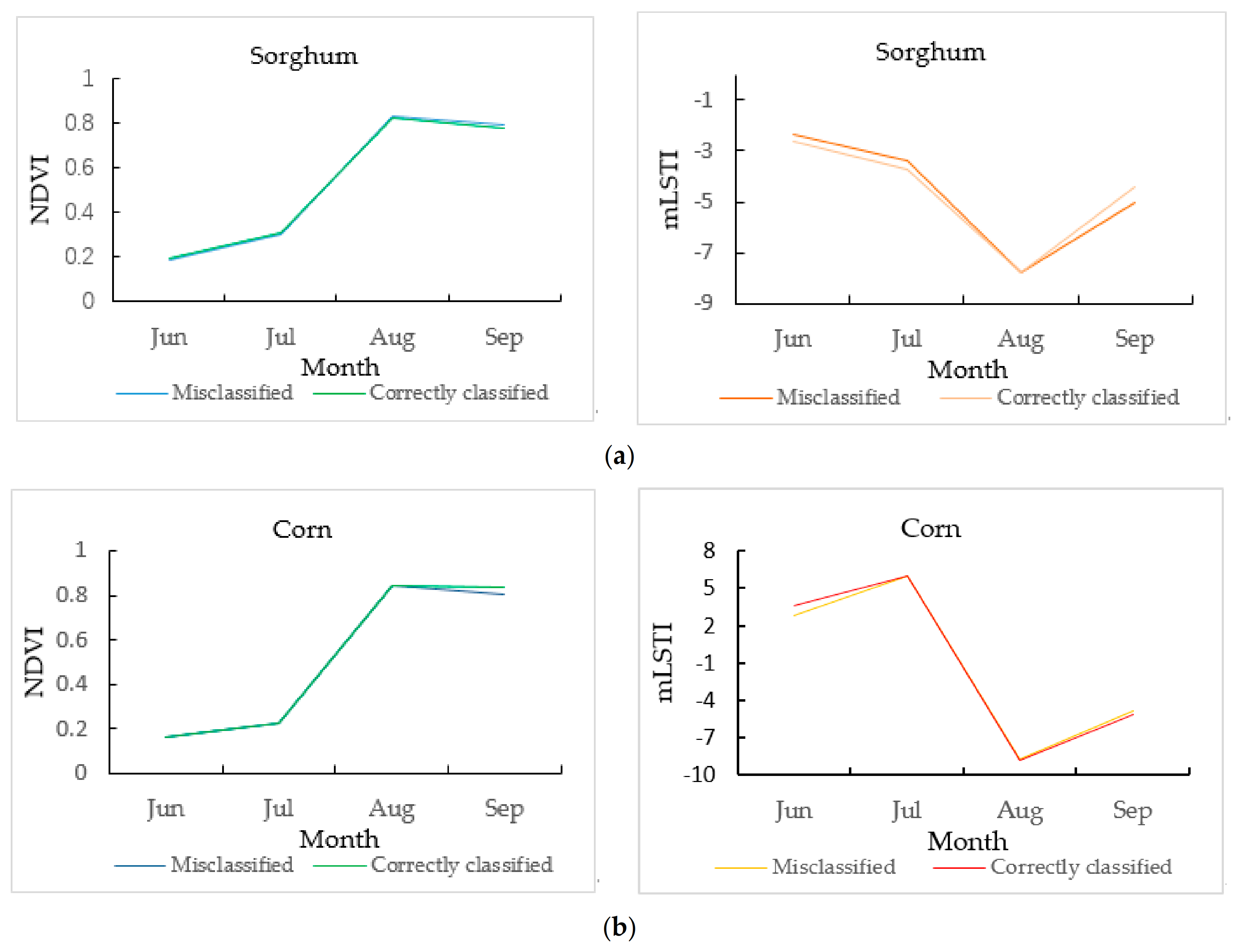
| Average Temperature of Study Area 1 (°C) | Average Temperature of Study Area 2 (°C) | Average Temperature of Study Area 3 (°C) | |
|---|---|---|---|
| June | 24.7 | 25.1 | 23 |
| July | 28.0 | 26.5 | 26.1 |
| August | 27.1 | 24.5 | 27.5 |
| September | 23.7 | 21.4 | 23.9 |
| October | 18.7 | 16.0 | 11.8 |
| November | 14.0 | 9.1 | 6.2 |
| Study Area 1 (2017) (WRS Path 43, Rows 34) | Study Area 2 (2016) (WRS Path 29, Rows 33) | Study Area 3 (2019) (WRS Path 30, Rows 36) | |
|---|---|---|---|
| June | 23th | 2nd | 26th |
| July | 25th | 20th | 4th |
| August | 26th | 21th | 29th |
| September | 11th | 6th | 14th |
| October | 13th | 8th | 8th |
| November | 14th | 25th | 9th |
| Images | Combination of Months |
|---|---|
| Time series 1 | June, July, August, September, October |
| Time series 2 | June, July, August, September |
| Time series 3 | June, July, August |
| Time series 4 | June, July |
| OA. (%) (NDVI) | OA. (%) (NDVI + mLSTI) | |
|---|---|---|
| Study area 1 | 82.0 | 85.6 |
| Study area 2 | 94.7 | 96.3 |
| Study area 3 | 90.9 | 91.2 |
| OA. (%) (NDVI) Area 1 | OA. (%) (NDVI + mLSTI) Area 1 | OA. (%) (NDVI) Area 2 | OA. (%) (NDVI + mLSTI) Area 2 | OA. (%) (vNDVI) Area 3 | OA. (%) (NDVI + mLSTI) Area 3 | |
|---|---|---|---|---|---|---|
| Times Series 1 | 80.7 | 82.7 | 93.6 | 96.2 | 89.4 | 88.9 |
| Times Series 2 | 82.1 | 82.3 | 92.4 | 94.0 | 87.9 | 87.0 |
| Times Series 3 | 70.6 | 81.9 | 85.5 | 90.1 | 86.1 | 87.4 |
| Times Series 4 | 66.8 | 77.5 | 75.3 | 80.0 | 64.7 | 69.7 |
| Corn | Sorghum | Soybeans | Winter Wheat | Alfalfa | |
|---|---|---|---|---|---|
| Prod. Acc. (NDVI) (%) | 94.68 | 92.07 | 92.94 | 98.25 | 91.62 |
| Prod. Acc. (NDVI + mLSTI) (%) | 95.89 | 96.03 | 96.81 | 98.55 | 91.77 |
| User Acc. (NDVI) (%) | 95.82 | 95.32 | 82.75 | 96.27 | 98.71 |
| User Acc. (NDVI + mLSTI) (%) | 98.64 | 97.16 | 87.90 | 96.50 | 98.96 |
| Corn | Sorghum | Soybeans | Winter Wheat | |
|---|---|---|---|---|
| Corn (%) | 84.3 | 2.38 | 18.79 | 1.17 |
| Sorghum (%) | 2.22 | 92.82 | 20.44 | 2.60 |
| Soybeans (%) | 13.49 | 0.60 | 54.84 | 1.23 |
| Winter Wheat (%) | 0.00 | 4.20 | 5.93 | 94.99 |
| Corn | Sorghum | Soybeans | Winter Wheat | |
|---|---|---|---|---|
| Corn (%) | 80.08 | 1.95 | 25.27 | 1.01 |
| Sorghum (%) | 2.85 | 92.86 | 17.14 | 2.46 |
| Soybeans (%) | 17.05 | 1.44 | 51.92 | 0.52 |
| Winter Wheat (%) | 0.03 | 3.76 | 5.66 | 96.01 |
© 2020 by the authors. Licensee MDPI, Basel, Switzerland. This article is an open access article distributed under the terms and conditions of the Creative Commons Attribution (CC BY) license (http://creativecommons.org/licenses/by/4.0/).
Share and Cite
Chen, X.; Zhan, Y.; Liu, Y.; Gu, X.; Yu, T.; Wang, D.; Liu, Q.; Zhang, Y.; Zhang, Y. Improving the Classification Accuracy of Annual Crops Using Time Series of Temperature and Vegetation Indices. Remote Sens. 2020, 12, 3202. https://doi.org/10.3390/rs12193202
Chen X, Zhan Y, Liu Y, Gu X, Yu T, Wang D, Liu Q, Zhang Y, Zhang Y. Improving the Classification Accuracy of Annual Crops Using Time Series of Temperature and Vegetation Indices. Remote Sensing. 2020; 12(19):3202. https://doi.org/10.3390/rs12193202
Chicago/Turabian StyleChen, Xinran, Yulin Zhan, Yan Liu, Xingfa Gu, Tao Yu, Dakang Wang, Qixin Liu, Yin Zhang, and Yunzhou Zhang. 2020. "Improving the Classification Accuracy of Annual Crops Using Time Series of Temperature and Vegetation Indices" Remote Sensing 12, no. 19: 3202. https://doi.org/10.3390/rs12193202









